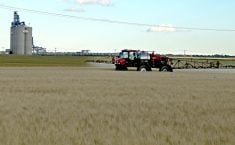When something is working, it’s difficult to change.
Such is the case with tight crop rotations in Western Canada, where many farmers grow only a couple of crops and plant canola as often as possible.
A canola-wheat-canola-wheat rotation on a farm near Tisdale, Sask., may be profitable right now, but might not be sustainable over the longer run.
That’s why the Western Grains Research Foundation has managed the Resilient Rotations project for the last four years. It is part of the Integrated Crop Agronomy Cluster, and the lead scientist is Kui Liu, an Agriculture Canada researcher in Swift Current, Sask.
Read Also

New coal mine proposal met with old concerns
A smaller version of the previously rejected Grassy Mountain coal mine project in Crowsnest Pass is back on the table, and the Livingstone Landowners Group continues to voice concerns about the environmental risks.
“We are approaching crop rotation by looking at a systems approach — all the elements that impact crop rotation from soil health, economics and yield to local growing conditions,” Liu said in a WGRF release.
Over the last several years, Liu and his team studied six crop rotations at seven sites across the Prairies.
The researchers separated the Prairies into three regions: northern Prairies, southern Prairies and Manitoba’s Red River Valley.
In the northern Prairies, for example, the research was done at Melfort and Scott in Saskatchewan, along with Beaverlodge and Lacombe in Alberta. At those sites, the scientists compared the performance of an “intense” wheat-canola-wheat-canola rotation to other options, such as:
- Diversified — pea, winter wheat, fababean, canola
- High risk — flax, soybean, durum, canola
- Soil health — forage pea green manure, winter wheat, fababan, canola
They also had a “market driven” rotation, in which canola was grown two or three times in a four-year period.
Instead of the usual approach, where a scientist publishes results in a journal and few read it, the WGRF is sharing the findings in a different way.
“We have produced 12 fact sheets with regional results on how each of the six rotations performed based on the evaluation criteria,” said Sheri Strydhorst, principal of Sheri’s Ag Consulting Inc., who helps manage communications and extension for the Resilient Rotations project.
The fact sheets are divided into different categories: net revenue, nitrogen use efficiency, yield and yield stability and precipitation use efficiency.
Sticking with the northern Prairies, the revenue data shows that a soil health rotation is the least profitable of the six rotations.
“The market driven and diversified rotations can have higher net returns, while the soil health rotation consistently has some of the lowest net returns,” the fact sheet says.
“The net returns associated with the market driven rotation are attributed to the high frequency of canola in the rotation and the high canola crop prices…. The market driven rotation often has canola being grown in three of four years, which is an agronomically risky practice (that) is not recommended due to the long-term impacts of canola disease.”
An important caveat is that the results and fact sheets are based on four years of data, which isn’t long enough to truly evaluate the different crop rotations.
The WGRF has applied to the Sustainable Canadian Agricultural Partnership to continue the project. It expects to hear later this spring if Resilient Rotations will be funded for another four to five years.
“Four years are under our belt. We hope to get the money to keep it going,” said Strydhorst, who surveyed farmers about crop rotations this winter.
She learned that farmers do want to diversify, but economics and financial realities get in the way.
“(About) 63 percent of growers agree or strongly agree that they need to diversify their current rotation…. It’s just not easy to do,” she said.
“(And) 67 percent of my respondents agreed or strongly agreed that net economic returns were the top reason that would cause them to switch. That’s going to be the driver, to get adoption of these more diverse rotations.”
The factsheets can be found at wgrf.ca/resilient-rotations-factsheet/.


















